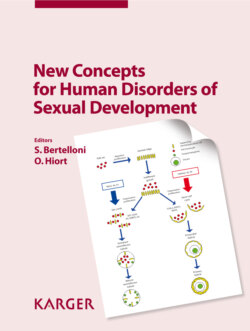Читать книгу New Concepts for Human Disorders of Sexual Development - Группа авторов - Страница 31
На сайте Литреса книга снята с продажи.
Perinatal Events in Testicular Maturation
ОглавлениеDuring the 3rd trimester of pregnancy, the fetal testes still produce large quantities of androgen but less than the peak activity at mid gestation. Closer to birth, at term age, the hormonal activity of the testes declines albeit being still clearly measurable. However, soon after birth in both sexes of primates, but best recognized in human males, the first few months are a period of high hormonal activity of the testes and the hypothalamic-pituitary axis [Grumbach, 2005]. The period is often referred to as the mini-puberty and characterised by a hormonal surge of gonadotropins and testosterone. This is associated with proliferation of Sertoli cells and some degree of germ cell development, i.e. transformation of gonocytes to Ad spermatogonia, at a time when gonadotropin, testosterone and inhibin B reach high levels. More detailed studies have shown that LH values begin to increase 2 weeks after birth and decline to prepubertal values by 1 year of age in both sexes. FSH values also begin to increase 2 weeks after birth and decline to prepubertal levels by 1 year of age in boys and 2 years of age in girls. In parallel, testosterone levels in boys often reach a peak of 10-15 nmol/l during the 2nd month of postnatal life but then decline to prepubertal low levels at 6 months of age [Forest et al., 1975]. However, the bioavailability of these high androgen levels has been questioned since high levels of SHBG in early infant boys may result in less circulating free and available testosterone levels in this age group. The biological role of the ‘mini-puberty’ for future testicular and male reproductive function is unknown but it has been speculated that it may add to aspects of germ cell maturation and the development of male gender identity.
